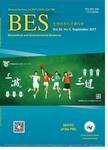Relationship between Iodine Content in Household Iodized Salt and Thyroid Volume Distribution in Children
Relationship between Iodine Content in Household Iodized Salt and Thyroid Volume Distribution in Children作者机构:Institute of Iodine Deficiency Disorders Center for Endemic Disease Control Chinese Center for Disease Control and Prevention Harbin Medical University Harbin 150081 Heilongiiang China Jiangsu Center for Disease Control and Prevention Nanjing 210009 Jiangsu China Qiqihar Medical University Qiqihar 161000 Heilongjiang China
出 版 物:《Biomedical and Environmental Sciences》 (生物医学与环境科学(英文版))
年 卷 期:2016年第29卷第6期
页 面:391-397页
核心收录:
学科分类:1002[医学-临床医学] 100201[医学-内科学(含:心血管病、血液病、呼吸系病、消化系病、内分泌与代谢病、肾病、风湿病、传染病)] 10[医学]
主 题:Thyroid volume Iodized salt Children Iodine deficiency disorders Universal salt iodization
摘 要:Objective To assess the effect of different levels of salt iodine content on thyroid volume(ThV) distribution using data from the 1999, 2011, and 2014 Chinese national iodine deficiency disorder(IDD) surveys. Methods Probability proportion to size(PPS) sampling method was used to obtain a representative national sample of 34,547, 38,932, and 47,188 Chinese children aged 8-10 years in 1999, 2011, and 2014 Chinese national IDD surveys, respectively. The iodine content in household iodized salt and urinary iodine concentration were measured and thyroid ultrasound examination was performed. The data were analyzed by SAS software using histograms and box plots. The skewness and kurtosis were calculated for testing the normality of ThV. Results The median iodine content in household iodized salt dropped from 42.30 mg/kg in 1999 to 25.00 mg/kg in 2014. The median urinary iodine concentration of children aged 8-10 years decreased from 306.0 μg/L in 1999 to 197.9 μg/L in 2014. The median and interquartile range(IQR) of ThV in 1999, 2011, and 2014 surveys were 3.44 m L and 1.50 m L, 2.60 m L and 1.37 m L, 2.63 m L and 1.25 m L, respectively. The skewness and kurtosis of ThV distribution in 1999, 2011, and 2014 surveys were 1.34 and 5.84, 0.98 and 3.54, 1.27 and 5.49, respectively. Conclusion With reduced salt iodization levels, the median urinary iodine concentration and median ThV of children decreased significantly, and the symmetry of the ThV distribution improved.



